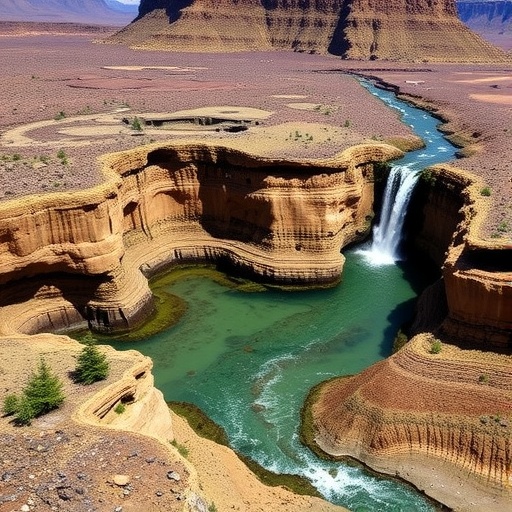A groundbreaking study recently published in Nature Geoscience unveils compelling new evidence illuminating the mysterious behaviors of ancient groundwater concealed beneath the ocean floor. This research not only advances our understanding of how these deep subsurface waters have interacted with ice sheet dynamics and sea level fluctuations over millennia but also sheds light on their broader implications for marine ecosystems and climate science.
Groundwater beneath the Earth’s surface is an indispensable resource, accounting for nearly half of the global domestic water supply. However, a significant proportion of this groundwater is classified as fossil water — ancient water that infiltrated subsurface reservoirs more than 11,700 years ago, before the onset of the Holocene epoch. These waters have remained isolated for such vast timescales that they are effectively non-renewable. Their longevity and vulnerability to contamination and saline intrusion present serious challenges for sustainable water management, especially in the face of accelerating environmental change.
The study, led by researchers at Stockholm University, takes on this challenge by probing how fossil groundwater beneath formerly glaciated regions has responded to drastic climatic events, including glacial retreats and associated sea level rises. Wei-Li Hong, a principal investigator in the Geological Sciences Department, highlights the importance of regions once cloaked by massive ice sheets, positing that the movement and chemistry of deep groundwater in these zones can offer critical clues about past environmental shifts.
One critical obstacle in understanding these processes has been the inaccessibility of subsurface environments beneath thick ice masses. Traditionally, drilling beneath glaciers to sample groundwater directly has been technically daunting and costly. To circumvent this barrier, the research team innovatively targeted submarine groundwater discharge, where fresh groundwater flows into the ocean. By examining waters emerging through the seabed offshore from northern Norway, they accessed a natural outflow reflecting underground hydrological processes beneath the former Fennoscandian ice sheet.
Sampling at approximately 760 meters below sea level along the Lofoten-Vesterålen margin, the researchers collected fluid samples uniquely freshened compared to typical seawater. This discovery is potent evidence that glacial meltwater had infiltrated the subsurface during the ice sheet’s maximum extent and subsequently discharged into the marine environment. The presence of this freshened groundwater suggests a previously underappreciated connection between past ice dynamics and subsurface hydrology.
Central to the study’s methodology was the use of radiocarbon dating of dissolved inorganic carbon in the submarine groundwater. Radiocarbon content serves as a robust chronological marker, revealing the last time the groundwater was in contact with the atmosphere prior to its subsurface isolation. PhD researcher Sophie ten Hietbrink explains that this technique enabled the team to constrain precisely when the groundwater flowed beneath the glacier and when seawater eventually replaced it during glacial retreat and marine transgression phases.
The temporal data indicate that during the height of glaciation—when ice thickness reached roughly one kilometer—meltwaters actively penetrated and replenished underground aquifers. However, following the collapse of the Fennoscandian ice sheet and the progressive advance of rising seas, this ancient fresh groundwater was slowly displaced by invading seawater. This seawater encroachment curtailed the discharge of fresh glacial meltwater into the ocean and altered the geochemical composition of subsurface fluids.
Notably, this infiltration of seawater into fossil groundwater systems poses significant implications for the longevity and quality of subterranean freshwater reserves beneath continental shelves. The study’s results suggest that without continual supply from glacial melt, these deep reservoirs become increasingly vulnerable to saline contamination on timescales of just a few thousand years, highlighting their fragility in a changing climate.
From a broader geoscientific perspective, the findings challenge previous conceptual models about the stability and dynamics of submarine groundwater systems during deglaciation. The interplay between ice sheet retreat, sea level rise, and groundwater flow revealed here underscores complex feedback mechanisms that may influence glacier mass balance by modulating basal hydrology and sediment stability beneath ice masses.
Furthermore, the research sheds light on potential biogeochemical impacts in coastal marine environments. As groundwater discharges into the ocean, it carries with it nutrients and carbon compounds that can affect local ecosystems and carbon cycling. Understanding the timing and chemistry of these discharges is therefore essential for predicting how coastal waters might respond to ongoing environmental perturbations.
Importantly, this study opens new avenues for future investigations into submarine groundwater flow in other glaciated regions, including Greenland, Antarctica, and the Arctic archipelago of Svalbard. Given the current trends of accelerated ice sheet melting in these areas due to anthropogenic warming, unraveling groundwater-ice sheet interactions will be critical for improving predictive models of sea level rise and freshwater input to oceans.
Wei-Li Hong emphasizes the urgency of continuing this line of work, noting that monitoring submarine groundwater systems could provide invaluable insights into the mechanisms driving glacier retreat and the subsequent fate of ancient freshwater reservoirs. As melting glaciers liberate more freshwater into the marine environment, understanding these subsurface processes may also inform water resource management and conservation strategies in coastal regions.
In summary, this innovative study represents a milestone in paleo-hydrogeology, revealing that fossil groundwater beneath the ocean floor is not a static relic but has been dynamically shaped by glacial-interglacial cycles. By combining cutting-edge radiocarbon analytical techniques with detailed marine sampling, the research unites hydrology, glaciology, and marine science to offer a more nuanced perspective on Earth’s changing climate system and its hidden freshwater archives.
Subject of Research:
Not applicable
Article Title:
Deglaciation drove seawater infiltration and slowed submarine groundwater discharge
News Publication Date:
6-Aug-2025
Web References:
http://dx.doi.org/10.1038/s41561-025-01750-z
References:
Hong, W.-L., ten Hietbrink, S., Chen, N.-C., et al. (2025). Deglaciation drove seawater infiltration and slowed submarine groundwater discharge. Nature Geoscience. DOI: 10.1038/s41561-025-01750-z
Image Credits:
Credit: Sophie ten Hietbrink
Keywords:
Ancient groundwater, fossil water, submarine groundwater discharge, radiocarbon dating, deglaciation, Fennoscandian ice sheet, sea level rise, glacial meltwater, ocean floor hydrology, climate change, marine geoscience, ice sheet stability




